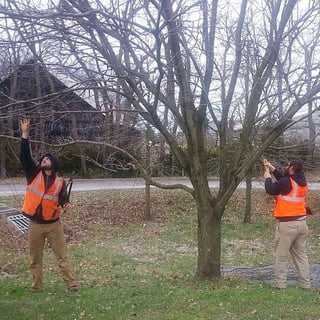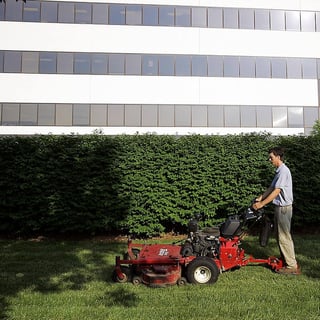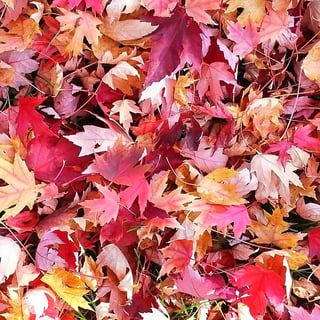We’re heading into fall, and now is the time to complete essential fall landscaping tasks to protect the investment in your landscape and ensure the health, safety and beauty of your commercial property.
We think of fall as the season when we put our landscapes to bed. Here are six must-do tasks that will contribute to the overall wellness of your landscape and its vitality come spring.
Aeration & Overseeding
Aeration is the process of removing cores of grass and soil to allow water, air and nutrients to reach plant roots. Aeration reduces thatch, a naturally occurring buildup of green matter where grass clippings and other organic materials collect on the surface. Aeration is a cultural practice designed to enhance soil and turf health, and we recommend aerating all Kentucky properties on an annual basis. The benefits of core aeration include: improving a lawn’s ability to absorb rainfall (therefore reducing stormwater runoff); and allowing organic material to seep into the soil to maximize absorption of essential nutrients.
Aeration gives your lawn breathing room and prepares the lawn for new growth.
Overseeding is a vital tool in keeping Kentucky fescue lawns looking their best. Why is overseeding necessary? Grass, like any plant, has a finite life span. Turf fescue is mostly a clumping grass, meaning it doesn’t spread by runners like bermuda grass will. The only way to get more fescue grass is through seed, and since continuously maintained turf isn’t allowed to flower and set seed the turf will eventually get thinner and thinner as the individual grass plants die. Unless, of course, the lawn is overseeded regularly to replenish with new fescue plants. When paired with aeration, we can rejuvenate turf areas impacted by weed pressure, drought, disease or foot-traffic, causing it to thin out.
The Last Month Of Mowing
Leaving grass clippings on turf is a great way to return organic matter and nitrogen to the soil. During the fall leaf removal season, the last couple of mows are performed with special mulching kits to chop up the leaves of trees to create nitrogen-rich organic matter - further adding to soil health. This organic matter delivers beneficial nutrients to soil and promotes future healthy turf development.
The final mow at the end of the growing season is important for minimizing the potential for disease to establish—particularly pink and gray snow mold. At the end of fall, the very last mow should bring turf down to 2 or 3 inches in height, depending on the turfgrass species. This shorter grass will prevent excessive moisture buildup in the turf stand and allow sunlight and air circulation to penetrate the lawn to minimize disease conditions.

Pruning & Removing Dead Limbs
The routine pruning of trees for safety, health and beauty is performed when trees are dormant. Cutting back diseased, dying or dead branches is important because these limbs can present a hazard to people and your property. Strong winds and heavy snow can cause compromised branches to break off—and this tearing can damage the tree itself. There is an art and science to proper pruning so the practice will benefit the tree.
Irrigation Winterization
Winterization is putting your irrigation system to bed. It involves draining out the irrigation system to remove all water from pipes and valves. A qualified irrigation technician performs this service before temperatures become freezing. (Do not procrastinate this fall service—or you could end up with freezing pipes, causing breaks and costly damage to the plumbing of your irrigation system.)
Leaf Removal
Leaf removal is a service of varying frequency depending upon site requirements. Property owners can choose the frequency of leaf removal to match their quality expectations. Most properties receive 3 leaf removals, but some opt for only 1 removal or as many as 5 removals. If your contract calls for only 1 leaf removal, your provider will wait until all the leaves have fallen before providing the service so expect a messy looking property until December.
Keeping up with fallen leaves with several clean-ups is more efficient than waiting until the end of leaf fall—and it is also beneficial to remove leaves from the property because leaf cover prevents air circulation and sunlight from reaching turf. Leaf removal can also be an effective strategy to reduce pests and diseases. Many pests and diseases over winter in leaf litter. Removing leaf debris is an important part of managing problems like fungal infections and spider mites.
Addressing Spruce Spider Mites
During the cool seasons—fall, winter, and spring—spruce trees can require extra attention to address spider mites, which are particularly active during these times of year. Nearly every spruce tree in Kentucky has spider mites and damages can vary between species and locations and from one year to the next. If spruce spider mites are ignored, a tree will suffer extensively and may require replacement. However, the good news is, spider mites can be treated with an Integrated Pest Management (IPM) strategy. Proper location and good airflow can help minimize conditions favoring spider mites. There are such things as beneficial spider mites which attack and eat the bad spider mites. Chemical control options are also available, but require exact monitoring and application timing to be effective. We highly recommend working with your account manager to develop IPM strategies to protect spruce trees. This preventive measure could save you significant cost down the road if trees are badly damaged and must be removed.
Fall Into Landscape Best Practices—And Set The Stage for A Strong Spring
In landscaping, we are always thinking at least one season ahead so we can prepare our properties to stay healthy, safe and beautiful. With fall nearly upon us, we’re watching leaves change color and our outdoor environments evolve. Capture this opportunity to fortify your natural environment by executing on some basic fall landscaping best practices that will help your landscape do more than look good—but grow strong and contribute to a beneficial ecosystem.
Let’s talk about what fall services your commercial Kentucky property needs this year. Call us any time in Lexington at 859-254-0762 and Louisville at 502-264-0127. Or, fill out this simple contact form and we’ll get in touch with you.




